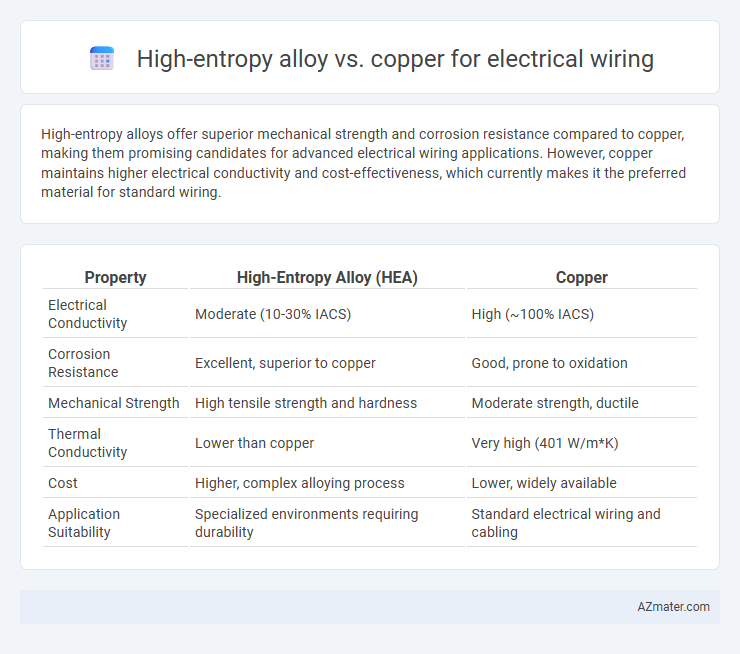High-entropy alloys offer superior mechanical strength and corrosion resistance compared to copper, making them promising candidates for advanced electrical wiring applications. However, copper maintains higher electrical conductivity and cost-effectiveness, which currently makes it the preferred material for standard wiring.
Table of Comparison
| Property | High-Entropy Alloy (HEA) | Copper |
|---|---|---|
| Electrical Conductivity | Moderate (10-30% IACS) | High (~100% IACS) |
| Corrosion Resistance | Excellent, superior to copper | Good, prone to oxidation |
| Mechanical Strength | High tensile strength and hardness | Moderate strength, ductile |
| Thermal Conductivity | Lower than copper | Very high (401 W/m*K) |
| Cost | Higher, complex alloying process | Lower, widely available |
| Application Suitability | Specialized environments requiring durability | Standard electrical wiring and cabling |
Introduction to High-Entropy Alloys and Copper in Electrical Wiring
High-entropy alloys (HEAs) are advanced materials composed of five or more principal elements in near-equal atomic ratios, offering exceptional mechanical strength, corrosion resistance, and thermal stability. Copper remains the dominant material for electrical wiring due to its excellent electrical conductivity, ductility, and cost-effectiveness in large-scale applications. Comparing HEAs to copper, HEAs provide enhanced durability and high-temperature performance, but they currently lag behind copper in electrical conductivity and widespread industry adoption.
Electrical Conductivity: High-Entropy Alloy vs Copper
Copper exhibits one of the highest electrical conductivities among metals, typically around 5.96 x 10^7 S/m at room temperature, making it the standard choice for electrical wiring. High-entropy alloys (HEAs), composed of multiple principal elements in near-equiatomic proportions, generally show electrical conductivities significantly lower than copper due to increased electron scattering from lattice distortions and atomic disorder. While some HEAs can be engineered to balance mechanical strength and conductivity, their electrical performance remains inferior to copper, limiting their practical application in standard electrical wiring where maximal conductivity is critical.
Mechanical Strength and Durability Comparison
High-entropy alloys exhibit significantly higher mechanical strength and enhanced durability compared to conventional copper used in electrical wiring, due to their multi-element composition that resists deformation and wear. Copper, while possessing excellent electrical conductivity, is relatively soft and prone to mechanical fatigue under stress, leading to potential wire breakage over time. The superior strength and corrosion resistance of high-entropy alloys make them promising candidates for wiring applications requiring extended lifespan and reliability in harsh environments.
Thermal Stability and Heat Resistance
High-entropy alloys exhibit superior thermal stability and heat resistance compared to copper, maintaining structural integrity at temperatures exceeding 800degC, whereas copper's performance degrades significantly above 400degC due to oxidation and softening. The complex multi-element composition of high-entropy alloys mitigates grain growth and phase transformation under thermal stress, enhancing reliability in high-temperature electrical wiring applications. Copper's high electrical conductivity is offset by its limited heat resistance, making high-entropy alloys a promising alternative for wiring in extreme environments requiring sustained thermal stability.
Corrosion Resistance in Electrical Environments
High-entropy alloys exhibit superior corrosion resistance compared to copper in electrical environments due to their complex multi-element composition, which forms stable passive oxide layers that protect against oxidation and degradation. Copper, while highly conductive, is prone to corrosion and tarnishing when exposed to moisture and harsh electrical conditions, leading to reduced electrical performance over time. The enhanced durability of high-entropy alloys ensures longer lifespan and reliability in wiring applications subjected to oxidative and corrosive stress.
Cost Analysis: High-Entropy Alloys versus Copper
High-entropy alloys (HEAs) present higher initial material costs compared to traditional copper due to complex alloying elements and manufacturing processes, which impacts overall expenditure in electrical wiring applications. Despite this, HEAs offer potential cost savings through enhanced durability, thermal stability, and corrosion resistance, reducing maintenance and replacement frequency. Copper remains cost-effective for bulk wiring due to its established supply chain and lower raw material prices, though HEA adoption may increase as production scales and technology advances.
Weight and Density Considerations
High-entropy alloys (HEAs) exhibit higher strength-to-weight ratios compared to copper, offering potential weight savings in electrical wiring applications. Copper has a density of 8.96 g/cm3, whereas many HEAs have densities ranging from approximately 6 to 8 g/cm3, which can reduce overall conductor mass. Lower density HEAs can decrease installation costs and improve efficiency in aerospace and automotive wiring systems without compromising electrical performance.
Manufacturing and Processing Challenges
High-entropy alloys (HEAs) present significant manufacturing and processing challenges compared to copper due to their complex multi-element composition, which complicates melting, casting, and homogenization processes. Achieving uniform microstructure and consistent electrical conductivity in HEAs requires precise control of temperature and cooling rates, making large-scale production more difficult and costly than the well-established processing techniques for copper. Copper's excellent ductility and well-understood annealing processes enable easier wire drawing and scalability, giving it a distinct advantage in electrical wiring manufacturing.
Applications in Modern Electrical Systems
High-entropy alloys (HEAs) offer enhanced mechanical strength, corrosion resistance, and thermal stability compared to conventional copper conductors, making them promising for high-performance electrical wiring in modern systems. Their superior resistance to electromigration and oxidation extends the lifespan of wiring in demanding environments such as aerospace, electric vehicles, and renewable energy installations. While copper remains the standard due to excellent electrical conductivity and cost-effectiveness, HEAs are increasingly explored for applications requiring robustness and reliability under extreme conditions.
Future Trends and Innovations in Wiring Materials
Future trends in electrical wiring highlight the growing interest in high-entropy alloys (HEAs) due to their exceptional mechanical strength, corrosion resistance, and thermal stability compared to traditional copper conductors. Innovations in HEA compositions aim to enhance electrical conductivity while reducing material weight, addressing the demand for more efficient and durable wiring in advanced electronics and electric vehicles. Research focuses on scalable manufacturing processes and optimizing HEA microstructures to achieve performance that can surpass copper's long-standing dominance in electrical wiring applications.

Infographic: High-entropy alloy vs Copper for Electrical wiring
 azmater.com
azmater.com